| The Jews of Riga during the Holocaust
http://www.deathcamps.org/occupation/riga_ghetto.html
German forces occupied Riga on 1-7-1941. Although some Jews had fled the city eastwards in the wake of the retreating Red Army, many others who had taken refuge from the invaders in Riga were now trapped there. On the first day of the occupation, Latvian collaborators began arresting thousands of Jewish men and imprisoning them in the Centralka and Terminka jails, as well as in police headquarters and at the premises of Perkonkrust. The prisoners were first brutalized, then approximately 2,700 of them were murdered in the nearby Bikernieki Forest. A further several thousand Jewish males were killed in Bikernieki Forest and at other locations during the course of July. On 4 July, Latvian volunteers set fire to the Chor synagogue, killing an unknown number of Jews who were locked inside the building, and later burned all other synagogues with the exception of the Pietstavas synagogue, which was left standing since adjacent buildings were occupied by Latvians.
Reichskommissar für das Ostland Hinrich Lohse governed his territory from Riga. Under him was Generalkommissar für Lettland Otto-Heinrich Drechsler. Lohse’s superior was Minister für die besetzten Ostgebiete (Minister for the Occupied Eastern Territories) Alfred Rosenberg, in Berlin.
Riga's streets were renamed. Brivibas (Liberty) Street became Adolf-Hitler-Straße. Another street was named for Walter von Plettenberg, grand master of the Livonian knights. Completely obscure Germans such as Carl Schirren, Karl Ernst von Baer, and Victor Hehn had streets named after them, while the Latvian epic hero Lacplesis, eminent poet Janis Rainis, and national awakening era leader Krisjanis Valdemars lost theirs. All signs and notices had to be first in German (above), and only then in Latvian (below). Germans were allocated larger food rations than Latvians, who were restricted to 700 calories a day. Rations for Jews were even more inadequate.
Einsatzgruppe A, initially commanded by SS-Brigadeführer Franz Walter Stahlecker, operated in the Baltic states, with Einsatzkommandos 1a (headed by SS-Standartenführer Martin Sandberger) and 2 (initially headed by SS-Sturmbannführer Rudolf Batz, subsequently by SS-Obersturmbannführer Eduard Strauch, then SS-Sturmbannführer Rudolf Erwin Lange) responsible for Riga. The headquarters of the Security Police and the SD for the Eastern Territories (BdS Reichskommissariat Ostland) were also situated in Riga. Odilo Globocnik’s representative in Riga was SS-Obersturmführer Georg Michalsen.
Although referring to events in Daugavpils (Dünaburg), there can be no doubt that the events described in Einsatzgruppen Operational Situation Report No.24 concerning the collaboration of Latvian auxiliaries, applied to an even greater extent to Riga, where by early August the Auxiliary Police (Schutzmannschaft) already numbered some 2,799 men (see Volunteer Auxiliaries):
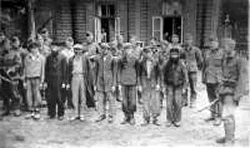
Making Jews look like Fools
“The auxiliary police force consists of former police constables, members of the former Latvian Army, and members of the former ATZSARGI organization (Organization for Self Defence)… By 7 July the Latvians arrested 1,125 Jews, 32 political prisoners, 85 Russian workers, and 2 women criminals, the greater part during the last days. This is due to the EK backing the Latvians. Actions against the Jews are going on in an ever-increasing number. Conforming to a suggestion of the EK, the Jews are being evacuated by the auxiliary police force from all houses still standing. The apartments are being allocated to non-Jewish inhabitants. The Jewish families are being driven out of town by the Latvians; most of the men have been arrested… The arrested Jewish men are shot without ceremony and interred in previously prepared graves. Until now the EK 1b has shot 1,150 Jews in Daugavpils.�
Over the next three months, a reign of terror was introduced for the Jews of Riga. Many were driven from their homes and had their possessions confiscated, others were rounded up for forced labour. Jews were forced to wear the Star of David, forbidden to use public transport, walk on the pavements, frequent public places, receive any schooling, or practice their professions. They were only permitted to purchase their restricted food rations from three stores. Physical assaults became commonplace.
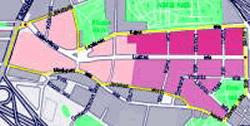
Riga Ghetto
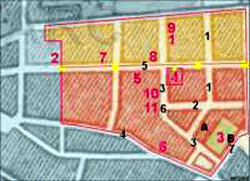
Riga "Rest-Ghetto"
On the order of Oberbürgermeister Hugo Wittrock, the Gebietskommissar, a ghetto was established in the "Moscow quarter" ("Moskauer Vorstadt") of Riga on 25 October 1941. As elsewhere, the extremely congested area of the ghetto was deliberately chosen for its dilapidated housing and inadequate sanitary conditions and supply of water. At least 29,602 Jews were incarcerated in the sealed ghetto (some sources suggest as many as 32,000), which was surrounded by a high fence and guarded by Latvian auxiliaries. An Ältestenrat (Council of Elders) was appointed, with Michael Elyashov as its head and a Jüdischer Ordnungsdienst (Jewish Police Force) was formed, commanded by Michael Rosenthal. The Ältestenrat did its best to make living conditions bearable. A hospital, medical clinic, pharmacy and home for the aged were established. Men and women were supplied to the Germans for forced labour, including the construction of the Salaspils concentration camp near the city.
Quite often the ghetto was visited by Germans and Latvian policemen who plundered the Jews. They took everything: furs, pictures, crystal, blankets, linen, and musical instruments. Only some of these things were sent to Germany as “a gift from the Latvian nation for the Germans who fought against the Bolsheviks.� Most of the stolen Jewish property was taken by Latvians and Gestapo men.
On 11 October 1941, SS-Obergruppenführer Friedrich Jeckeln was appointed Höherer SS- und Polizeiführer für das Ostland (HSSPF), and thus became the person responsible for the carnage that ensued. Jeckeln met with Himmler on 10 or 11 November 1941, when, according to Jeckeln’s post-war testimony, Himmler said:
“that all Jews in the Ostland had to be destroyed to the last man.�
Jeckeln’s predecessor, Hans-Adolf Prützmann, had indicated to Himmler that Lohse was against the liquidation of the Riga Ghetto, but Jeckeln was ordered to carry it out anyway. Himmler went on:
“You tell Lohse, that is my order, which is also the Führer’s wish!�
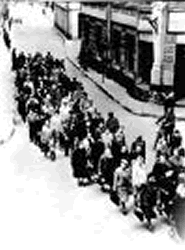
Deportation *
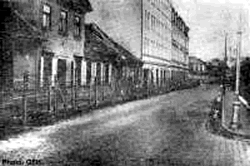
The Ghetto *
On 19 November 1941, working Jews were separated from the rest of the ghetto population and moved to a section in the northeast corner of the ghetto that had been cleared for the purpose. This area became known as the “Small Ghetto.� On the night of 29-30 November, the western section of the “Large Ghetto� was surrounded and the Jews gathered into groups of 1,000. The Jews had been told that they were simply being sent to a new camp nearby and to pack a 20-kilogram suitcase for the trip. Some people who had heard about the “resettlement� and interpreted this in fact to mean the physical liquidation of the Jews, decided to commit suicide. The next morning the groups were taken to the Rumbula Forest, 8 km from Riga, and shot. Large pits had been prepared for the purpose. Many people were killed on the ghetto streets or in their houses in the course of the Aktion. The drunken Latvian policemen, commanded by Herbert Cukurs, a famous former Latvian pilot who in 1933 flew over Africa and during the war was a German auxiliary police officer known as “The Butcher of Riga�, killed all the elderly Jews from the old people’s home. On that day, and continuing on 8 and 9 December, the entire population of the “Large Ghetto� was murdered, including most of the members of the Ältestenrat, the historian Simon Dubnow, and Rabbi Manahem Mendel Zak, the Chief Rabbi of Riga. In total, 27,800 Jews were killed in the Rumbula Forest in these Aktionen. One of the few survivors was Frida Frid-Mikhelson:
“Our column was divided up and everyone was ordered to undress… The Germans kept prodding us with their rifle butts closer and closer to the pit… Jews were already walking there one at a time, and vanishing behind the precipice – one could only hear the rattle of automatic rifles…I ran up to the officer who was in charge of the execution…He hit me in the head with his pistol, and I fell down. I was right next to the pit where the dead were being thrown. I pressed myself to the ground and tried not to move. A half hour later I heard someone shout in German: `Put the shoes here!’ By this time I had already crawled back a little. Just then, something was being thrown at me. I opened one eye slightly and saw a shoe lying next to my face. I was being covered up with shoes…Shots resounded quite close to me, and I could distinctly hear the last cries of people, the moans of the wounded who were thrown alive into the common grave. Some died cursing at their executioners, others died remembering their children and parents, others read prayers aloud…
… By evening the shooting had stopped… I decided to crawl out from under the pile of shoes… I crawled over to another pile – it was men’s clothing… I put on someone’s trousers and jacket and tied a big kerchief around my head… I came across a blanket cover, wrapped myself in it and began to crawl…�
Frida Frid-Mikhelson was sheltered by two Latvian families, the Berzins’ and Mezulis’, and later by a group of Seventh Day Adventists, who hid her and supplied her with food throughout the entire period of German occupation.
In addition to the killing sites at Rumbula and Bikernieki, concentration or labour camps were established in the vicinity of Riga at Kaiserwald (Mezaparks), Salaspils and Jungfernhof (Jumpravmuita), where executions were also carried out.
On 11 October 1941, Stahlecker visited Drechsler and informed him that in accordance with a “wish� of the Führer, a “big concentration camp� was to be established near Riga for Reich Jews. Lange (of Einsatzkommando 2) telephoned Drechsler on 21 October to report that it was planned to set up a camp (Salaspils) for 25,000 Reich Jews about 18 km from Riga. Lange then wrote to Lohse on 8 November confirming his conversation with Drechsler. When the Reichskommissariat political expert Regierungsrat Trampedach contacted the Ostministerium in Berlin to urge that the transports be stopped, he was informed by the chief of the ministry’s Political Division, Dr Leibbrandt, that there was no cause for worry, as the Jews would be sent “farther east� anyway – that is, they would be killed.
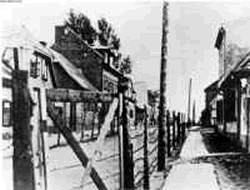
The Ghetto Fence *
After the Aktionen of November and December 1941, some 4,000 Latvian Jewish men were left in the “Small Ghetto�, as well as a number of Latvian Jewish women seamstresses, who were accommodated in two houses at Ludzas 68-70, which became known as the “Women’s Ghetto.� The arrivals from the Reich were placed in the “Large Ghetto�, now named the “German Ghetto.� The two ghettos were now quite separate, each with its own institutions, those of the “Small Ghetto� being headed by A.Kelman.
Although their eventual fate was never in doubt, to an extent the Jews of Riga had been murdered in order to make room from deportees from the Reich. It is considered most probable that in mid-September 1941, after much procrastination, Hitler tentatively approved of the deportation of the Jews of the Reich, a decision confirmed in early October. Their destinations were to be Lodz, Minsk, Kaunas (Kovno), and Riga. Between 27 November and 15 December 1941, 10 or 11 transports departed from Berlin, Nürnberg, München, Stuttgart, Wien, Hamburg, Köln, Kassel, and Düsseldorf for Riga. They were followed between 9 January and 21 February 1942 by another 10 or 11 transports from Terezin (Theresienstadt), Leipzig, Dortmund, Münster, and Dresden, as well as further transports from Berlin and Wien. It had been intended to deport 25,000 Reich Jews to Riga. In the event, the first five transports scheduled for that destination were rerouted to Kovno (Kaunas), so that the total number actually deported to Riga was 20,057. Only 3-4% of them were to survive.
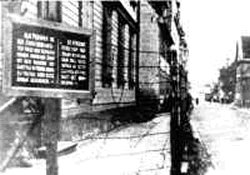
The Ghetto Fence *
The first transport of German Jews from Berlin arrived in Riga on the morning of 30 November and were immediately killed at Rumbula. Himmler had ordered that the deportees be temporarily lodged in the space made available by the murder of Latvian Jews. Himmler telephoned Heydrich in Berlin at 1:30 p.m. on 30 November noting in his telephone log:
“Jewish transport from Berlin. No liquidation.�
It was too late; the Berlin Jews were already dead. The following day Himmler told Jeckeln:
“The Jews resettled in the Ostland are to be dealt with only according to the guidelines given by me or by the RSHA acting on my behalf. I will punish unilateral acts and violations.�
Thereafter, Jews from the Reich were settled in the Riga Ghetto or in the nearby camps of Salaspils and Jungfernhof, with two exceptions. The second transport from Terezin (Theresienstadt), departing on 15 January 1942, was liquidated on arrival. And the transport leaving Wien on 6 February was met by a gas van; 700 of the 1,000 deportees were immediately murdered. Among those on this transport was Gertrude Schneider, who recorded that the train was met by Lange, who had a little more than two weeks earlier had been present at the Wannsee Conference. Heydrich, impressed with the efficiency with which Lange had organised the slaughter of the Latvian Jews of Riga, had invited him to the conference. Lange told the arriving deportees that those “unwilling or unable� to walk the 7 km to the ghetto could make the journey on trucks which had been especially reserved for them. Gertrude Schneider’s account continues:
“It was an extremely cold day – forty-two degrees below zero to be exact – and so the majority of the hapless, unsuspecting Jews from Wien took his advice and lined up to board the trucks. They did not know that those greyish-blue trucks had been manufactured by the Saurer Works in Austria especially for the implementation of the `Final Solution.’ These trucks were the famous gas-vans, which were used from time to time despite the fact that the SS did not especially like them because they always had mechanical problems.�
One of more than 1,500 Jews deported from Wien on 11 January 1942 was Liana Neumann. She recalled:
“There was no water. The coaches were sealed, and we could not leave them. It was very cold, and we chipped off some ice from the windows to have water…(On reaching Riga) we were received by SS men, who made us run, and beat us up.�
Liana Neumann was sent to work in a hospital, where it was her job to disinfect the clothing of murdered Jews.
In an undated report of early 1942, Stahlecker outlined the condition of the Reich Jews:
“Of the Jews from the Reich only a small portion are capable of work. Some 70-80% are women and children as well as elderly persons incapable of work. The mortality rate is also climbing steadily, as a result of the extraordinarily harsh winter…In individual cases infectious Jews were separated and executed under the pretext of being sent to a Jewish old people’s home or hospital."
Within a few months 50% of the Reich Jews sent to Riga were dead.
According to Jeckeln, even in late January 1942, Himmler was still uncertain about how to kill the remaining Reich Jews in Riga. He told Jeckeln there would be further transports arriving but “that he had not yet decided in which way they were to be destroyed… to be shot in Salaspils or to be chased off somewhere into a swamp.�
Jeckeln replied that “shooting would be an easier and quicker death.�
Consequently, in February, and in particular on 26 March 1942, large selections took place in both Jungfernhof and the ghetto. Almost 3,000 people regarded as unfit for work fell victim to these selections. Under the pretext that they would be taken to a camp in Dünamünde (which did not actually exist), where the working conditions in a preserved food factory would supposedly be easier, the victims were transported to the mass graves in the woods of Bikernieki and executed.
Gertrude Schneider and her family were taken to Jungfernhof, where there were continual “selections.� She was present at the one that took place on 26 March 1942. The following day several trucks were unloaded in the ghetto:
“Their cargo was an assortment of personal effects of the people who had been resettled. There were clothes that had been taken off hurriedly by their owners – still turned inside out – stockings attached to girdles and shoes encrusted with mud. The trucks also yielded nursing bottles, children’s toys, eye-glasses, bags filled with food, and satchels containing photographs and documents…
…(As women worked at sorting the effects) they recognized many of the clothes, some by the names that had been sewn into them, some by the identity cards still in their pockets, and there were of course, dresses, coats, and suits which they had seen on their friends and neighbours when they had left the ghetto only a few days before…Soon everyone in the ghetto knew about the cargo that the trucks had brought and about the condition of the clothes. It did not take any great imagination to understand what had happened to their owners. No longer did anyone scoff at the tales of the Latvian Jews nor think that this could happen only to `Ostjuden’ [eastern European Jews] and never to the Jews from Germany. In many houses in the ghetto, `Kaddish’, the Hebrew prayer for the dead was recited. The German ghetto was plunged into despair.�
A number of discussions had occurred in Nazi circles in late October 1941 concerning the possible construction of an extermination camp in Riga. On 25 October, Ostministerium Jewish expert Erhard Wetzel drafted a letter for Rosenberg concerning conversations he had had with Viktor Brack of the Führer Chancellery and Adolf Eichmann of the RSHA. According to Wetzel, Brack was ready to aid in the construction of “gassing apparatuses� in Riga.
Brack offered to send his chemist, Dr Kallmeyer, to Riga, where he would take care of everything. Eichmann had confirmed that camps were about to be set up in Riga and Minsk to receive the Reich Jews. Those capable of labour would be sent “to the east� later, but there would be no objections “if those Jews who are not fit for work are removed by Brack’s device.�
Wetzel testified that at their meeting, Brack had told him that this was “a question of a Führer order or a mandate of the Führer.�
In the event, Kallmeyer did not go to Riga. Instead, in mid-December 1941, two small Diamond gas vans and one large Saurer gas van were brought from Berlin to Riga for the use of the BdS there. According to the deposition of an official named Trühe, head of the supply section at BdS Riga, a total of six gas vans were eventually dispatched by the RSHA in Berlin to BdS Riga, of which at least one or probably two were utilised in Riga itself. Dr August Becker, responsible for supervising the use of gas vans in occupied Soviet territory, saw one of these vehicles in Riga in June 1942. Another eyewitness, a Jew from Riga named Mendel Vulfovich testified:
“In February 1942, I saw with my own eyes 2,000 elderly Jews from Germany, men and women, being loaded into special gas vans. These vans were painted grey-green and had a large closed cargo compartment with hermetically sealed doors. All those inside were killed by gas.�
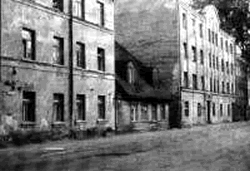
The Kommandantur
On 8 February 1942, 380 Jews from Kovno (Kaunas) were deported to Riga, to be followed by a further 300 on 24 October. Once again, an attempt was made to restore some semblance of normality to life in the ghetto; a clandestine grocery and bakery was set up, a school for the few remaining children was established and cultural events were organized. A resistance group was also established in the ghetto. At the beginning of 1942, the advocate Jewelson issued a slogan calling on the Jews to organize themselves. Small groups of fighters were created and the members of the resistance gathered weapons and food. Jewish women who worked as tailoresses in German factories smuggled German uniforms into the ghetto. The resistance groups were preparing to escape from the ghetto and to join units of Soviet partisans. Because of treason on the part of one Gestapo provocateur, all of the plans were discovered and monitored by the Germans.
On 28 October 1942, when a large group of fighters tried to escape from Riga, the Germans stopped their truck in the suburbs. All of the members of the group were killed during the ensuing battle – altogether, 105 people. Because the Gestapo knew that Jewish policemen were among the organizers of the resistance, they decided to take their revenge mainly on them. On 31 October, all Jews from the Small Ghetto were gathered for a selection. 108 Jews classified as unfit for work were shot. 39-40 Jewish policemen were executed at the courtyard of the commandant’s house. The entire resistance organisation had been liquidated by the Gestapo.
On 1 November 1942 the “Small Ghetto� was incorporated into the “German Ghetto". There was now a single ghetto divided into two sections: Section “R� for Jews from the Reich and section “L� for Latvian Jews. A joint ghetto council was established and the Ordnungsdienst unified into a single body. In the increasingly fraught atmosphere, many Jews began living at their place of work. Gradually, the ghetto emptied of its inhabitants. In the summer of 1943, some of the Jews still living in the ghetto were transferred to the Kaiserwald camp or to other labour camps in the region. That November, large-scale Aktionen were carried out in the ghetto and at the places where Jews were employed.
As the Soviet Army advanced towards Latvia in 1944, the Germans began Sonderkommando 1005 operations in the Riga area. In order to obliterate the evidence of the crimes that had been committed, Jewish prisoners were forced to exhume and cremate the corpses of victims at the killing sites. In April 1944 more than 500 Jewish women from Hungary were sent to Kaiserwald. In June 1944, when Soviet forces were already at the Latvian border, Aktionen took place in which many Jews of Kaiserwald and its satellite camps were killed. The remaining Jews were sent to concentration camps outside of Latvia, chiefly to Stutthof. It has been estimated that 15,000 prisoners were incarcerated at the Salaspils camp during its existence. Just 192 of them are known to have survived.
Not all Latvians were collaborators or bystanders. Several dozen Jews were sheltered by Yanis Lipke in a cave he had dug under his henhouse. In addition to providing shelter for the hidden Jews, Lipke smuggled food and medicine into the ghetto. He also found three other men to help him save the Jews of the nearby village of Dobele – Yanis Undulis, and the brothers Fritz and Yan Rosenthal. Two of the Dobele Jews were hidden in a haystack at Yan Rosenthal’s farm. Several more were hidden at a farm belonging to Fritz Rosenthal’s aunt, Wilhelmina Putrinia. Lipke was not finished. He rescued Isaak Dryzin, his brother and another man, Sheyenson, from the ghetto itself on Yom Kippur, 10 October 1943. Lipke took them to the nearest doorway, tore off their yellow stars, gave them peasants’ hats to put on, and drove them to the farm of another friend, where they were hidden in barns and haystacks. He told the Dryzin brothers:
“Tomorrow I will go to the ghetto again and will keep bringing people here every day.�
– which is exactly what he did. In recognition of his outstanding heroism, Yanis Lipke was recognized as a “Righteous Among the Nations� by Yad Vashem.
The Soviet Army liberated Riga on 13 October 1944. A few days later 152 surviving Jews, including a few children, emerged from their hiding places and were taken by the NKVD (precursor of the KGB) for interrogation. The NKVD asked them only one question – how had they survived? The Russians suspected them of collaboration with the Germans. In addition, those survivors who organized a commemorative ceremony at the Jewish cemetery were under suspicion. Many of the survivors were arrested and deported to Siberia. Among them were German Jews who had survived the occupation in Riga. Under Soviet rule, for many years the mass executions sites in Rumbula and Bikernieki Forests were the forgotten places of the Holocaust. Even when memorials were built, Jews from Riga could not organize official commemorative events there.
About 600 Jews had survived in the whole of Latvia, with a further 400 Latvian Jews surviving in German concentration camps. In the post-war years, the authorities encouraged citizens from other regions of the Soviet Union to settle in Riga. Today (2005) there are an estimated 9,000 Jewish inhabitants of the city out of a total population of 800,000. Memorials were erected to the victims of Rumbula in 1962, and to those of the Bikernieki Forest in 2001. The Salaspils Memorial Park was opened on 31 October 1967. The most recent memorial at Kaiserwald was dedicated on 29 June 2005. Following the collapse of the Soviet Union, Latvia regained its independence on 21 August 2001, and in 2004 became a member of both NATO and the European Union.
Trials and Retribution:
In 1919, Herberts Cukurs was a Bolshevik sympathizer. In independent Latvia he became famous as a pilot. Between 1924 and 1936 he designed and constructed a number of airplanes, and in 1933-1934 he flew from Riga to Gambia and back in one of his own planes, the C-3 (Gambia in West Africa, had been a colony of the Duke of Kurland in the 17th century). Two years later he flew from Riga to Tokyo. He also visited Palestine, and his reports of the visit were coloured with strong anti-Semitism. As soon as the German army entered Riga, Cukurs joined those who were shooting Jews. At the end of 1941 he personally participated in the shootings in Riga's Ghetto and Rumbula, killing infants and dancing with joy by the graves. After the war Cukurs found refuge in Brazil, running a boat and plane rental service on the Rio de Janeiro beach, and later owned a banana plantation. On 24 February 1965, he was killed in Uruguay's capital, Montevideo, by members of a group called “Those Who Do Not Forget.� It is said that they were agents of Mossad, the Israeli secret service.
Rosenberg was arraigned before the IMT at Nürnberg, found guilty on all counts and executed on 16 October 1946; Lohse was arrested in 1945, sentenced to 10 years imprisonment in 1948, but released in 1951 on the grounds of ill health. He died in 1964. Stahlecker was killed in 1942 in a battle with Soviet partisans; Sandberger was sentenced to life imprisonment by a U.S. tribunal in 1948, but released in 1953; Batz committed suicide in 1961 whilst on remand; Strauch was sentenced to death by hanging at the Einsatzgruppen trial, extradited to Belgium and condemned to death again. The execution was stayed because of insanity. Lange is believed to have been killed in the battle for Poznan (Posen) in 1945; Jeckeln was tried in Riga, sentenced to death on 3 February 1946 and hanged that afternoon. Brack was a defendant in The Medical Case at Nürnberg, was sentenced to death by a U.S. tribunal and executed in 1948. ....
For the entire article go to; http://www.deathcamps.org/occupation/riga_ghetto.html
|







